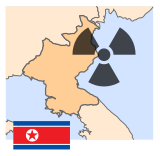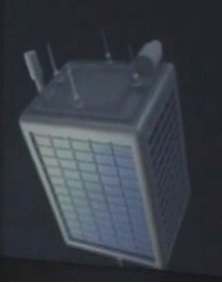 |
|
The 2014 North Korean missile tests were a series of North Korean missile tests in 2014.
 |
|
The 2014 North Korean missile tests were a series of North Korean missile tests in 2014.
The Rodong-1 (spelled Nodong-1 or simply Nodong in South Korea) is a single stage, mobile liquid propellant medium range ballistic missile developed by North Korea. Developed in the mid-1980s, it is an adaptation of the Soviet SS-1, more commonly known by its NATO reporting name "Scud".
It is believed North Korea obtained Scud-B designs from Egypt and possibly Scud-C designs from China, and reverse-engineered them into a larger, longer-distance weapon dubbed the Rodong. United States reconnaissance satellites first detected this type in May 1990 at the Musudan-ri test launch facility. [1]
The precise capabilities and specifications of the missile are unknown; even the fact of its production and deployment are controversial. [2] Rodong-1 technology has been exported. Variants are believed to be the basis for Iran's Shahab-3 and Pakistan's Ghauri missiles. [3]
On June 30, 2014, North Korea tested "launches of tactical ballistic rockets aimed at U.S. and South Korean forces, the second such launch drill reported in state media in three days." South Korea protested because the missiles were launched "without designating a no-sail zone." Kim Min-seok, the South Korean Defense Ministry spokesman, said, "it was difficult to conclude the purpose of Sunday's launches" and Michael B Kelley, another commentator, said "The staged scene, purely for domestic consumption, fits the impoverished country's glorification of war and deification of its Supreme Leaders." [4]
On July 2, 2014, South Korea reports that North Korea fired two short range missiles into the Pacific Ocean from the coastal city of Wonsan. On July 9, South Korea claims that North Korea has fired two short range missiles into the ocean to the east of the Korean Peninsula. On July 13, Japan's Defence Ministry claims that North Korea has fired two ballistic missiles into the Sea of Japan. On July 14, South Korea claims that North Korea has fired dozens of artillery shells into the sea near the disputed border.

North Korea has a military nuclear weapons program and, as of early 2020, is estimated to have an arsenal of approximately 30-40 nuclear weapons and sufficient production of fissile material for 6-7 nuclear weapons per year. North Korea has also stockpiled a significant quantity of chemical and biological weapons. In 2003, North Korea withdrew from the Treaty on the Non-Proliferation of Nuclear Weapons (NPT). Since 2006, the country has been conducting a series of six nuclear tests at increasing levels of expertise, prompting the imposition of sanctions.
The Hwasong-7, also known as Rodong-1 or Nodong-1, is a single-stage, mobile liquid propellant medium-range ballistic missile developed by North Korea. Developed in the mid-1980s, it is a scaled up adaptation of the Soviet SS-1, more commonly known by its NATO reporting name "Scud". Inventory is estimated to be around 200–300 missiles. US Air Force National Air and Space Intelligence Center estimates that as of June 2017 fewer than 100 launchers were operationally deployed.

Terminal High Altitude Area Defense (THAAD), formerly Theater High Altitude Area Defense, is an American anti-ballistic missile defense system designed to shoot down short-, medium-, and intermediate-range ballistic missiles in their terminal phase by intercepting with a hit-to-kill approach. THAAD was developed after the experience of Iraq's Scud missile attacks during the Gulf War in 1991. The THAAD interceptor carries no warhead, but relies on its kinetic energy of impact to destroy the incoming missile. A kinetic energy hit minimizes the risk of exploding conventional-warhead ballistic missiles, and the warhead of nuclear-tipped ballistic missiles will not detonate upon a kinetic-energy hit.
Taepodong-1 was a three-stage technology demonstrator developed by North Korea, a development step toward an intermediate-range ballistic missile. The missile was derived originally from the Scud rocket and was tested once in 1998 as a space launch vehicle. As a space launch vehicle, it was sometimes called the Paektusan 1.
The Ghauri–I is a land-based surface-to-surface medium-range ballistic missile, in current service with the Pakistan Army's Strategic Forces Command— a subordinate command of Strategic Plans Division.
The Taepodong-2 is a designation used to indicate what was initially believed to be a North Korean two or three-stage ballistic missile design that is the successor to the Taepodong-1 technology demonstrator. In 2012 the U.S. Department of Defense assessed that the Taepodong-2 had not been deployed as a missile. The Taepodong-2 is the technology base for the Unha space launch vehicle, and was likely not intended as ICBM technology.

Two rounds of North Korean missile tests were conducted on July 5, 2006. The Democratic People's Republic of Korea reportedly fired at least seven separate missiles. These included one long-range Taepodong-2 missile and short-range Scud derived missiles including the enlarged Nodong missile. The Taepodong-2 was estimated by United States intelligence agencies as having a potential range reaching as far as Alaska, although this missile failed after about 42 seconds of flight.

Hyunmoo-3 is a new cruise missile that is to be fielded with the military of Republic of Korea. It is designed by Agency for Defense Development (ADD). The name Hyunmoo comes from a mythical beast described as the "Guardian of the Northern Sky", perhaps hinting North Korea.

The Korean People's Army Strategic Rocket Force, also known as Missile Guidance Bureau is a military branch of the Korean People's Army that oversees North Korea's nuclear and conventional strategic missiles. It is mainly armed with surface-to-surface missiles of domestic design as well as older Soviet and Chinese models. The KPA-SRF was established in 1999 when several missile units under KPA Ground Force Artillery Command were re-organized into a single missile force reporting directly to the office of the Supreme Commander of the KPA via the General Staff.
The Hwasong-6 is a North Korean tactical ballistic missile. It is derived from the Hwasong-5, itself a derivative of the Soviet R-17 Elbrus. It carries the NATO reporting name Scud.

The Unha or Eunha is a North Korean expendable carrier rocket, which partially utilizes the same delivery system as the Taepodong-2 orbital launch system.

Kwangmyŏngsŏng-2 was a satellite launched by North Korea on April 5, 2009.

Two rounds of North Korean missile tests were conducted in July 2009. On July 4, 2009, the Democratic People's Republic of Korea launched seven short range missiles into the Sea of Japan, after previously launching four missiles two days earlier on July 2. The missiles were launched in violation of United Nations Security Council Resolution 1874.
The Hwasong-10, also known by the names BM-25 and Musudan, is a mobile intermediate-range ballistic missile developed by North Korea. Hwasong-10 was first revealed to the international community in a military parade on 10 October 2010 celebrating the Korean Worker's Party's 65th anniversary, although experts believe these were mock-ups of the missile. Hwasong-10 resembles the shape of the Soviet Union's R-27 Zyb submarine-launched missile, but is slightly longer. It is based on the R-27, which uses a 4D10 engine propelled by unsymmetrical dimethylhydrazine (UDMH) and nitrogen tetroxide (NTO). These propellants are much more advanced than the kerosene compounds used in North Korea's Scuds and Nodong missiles.

A Scud missile is one of a series of tactical ballistic missiles developed by the Soviet Union during the Cold War. It was exported widely to both Second and Third World countries. The term comes from the NATO reporting name attached to the missile by Western intelligence agencies. The Russian names for the missile are the R-11, and the R-17Elbrus. The name Scud has been widely used to refer to these missiles and the wide variety of derivative variants developed in other countries based on the Soviet design.
The following lists events that happened in 2014 in North Korea.
The following lists events that happened in 2013 in the Democratic People's Republic of Korea.
The Pukkŭksŏng-1 or Bukgeukseong-1, alternatively KN-11 in intelligence communities outside North Korea, is a North Korean, submarine-launched ballistic missile (SLBM) that was successfully flight tested on 24 August 2016. As of 2019, there have been no flight tests since.
Pukkuksong-2 also known as KN-15 by intelligence outside of North Korea, is a medium-range or intermediate-range ballistic missile under development by North Korea, which unlike the nation's earlier designs, uses solid fuel. Described as 'nuclear-capable', its first test flight was on 12 February 2017. The state-run KCNA news agency said that leader Kim Jong-un supervised the test, which was described as a success.